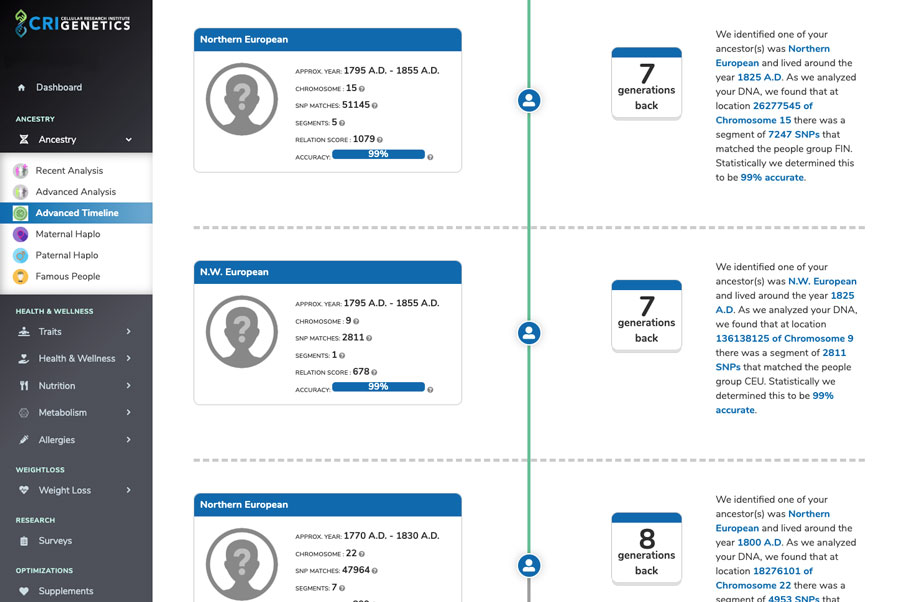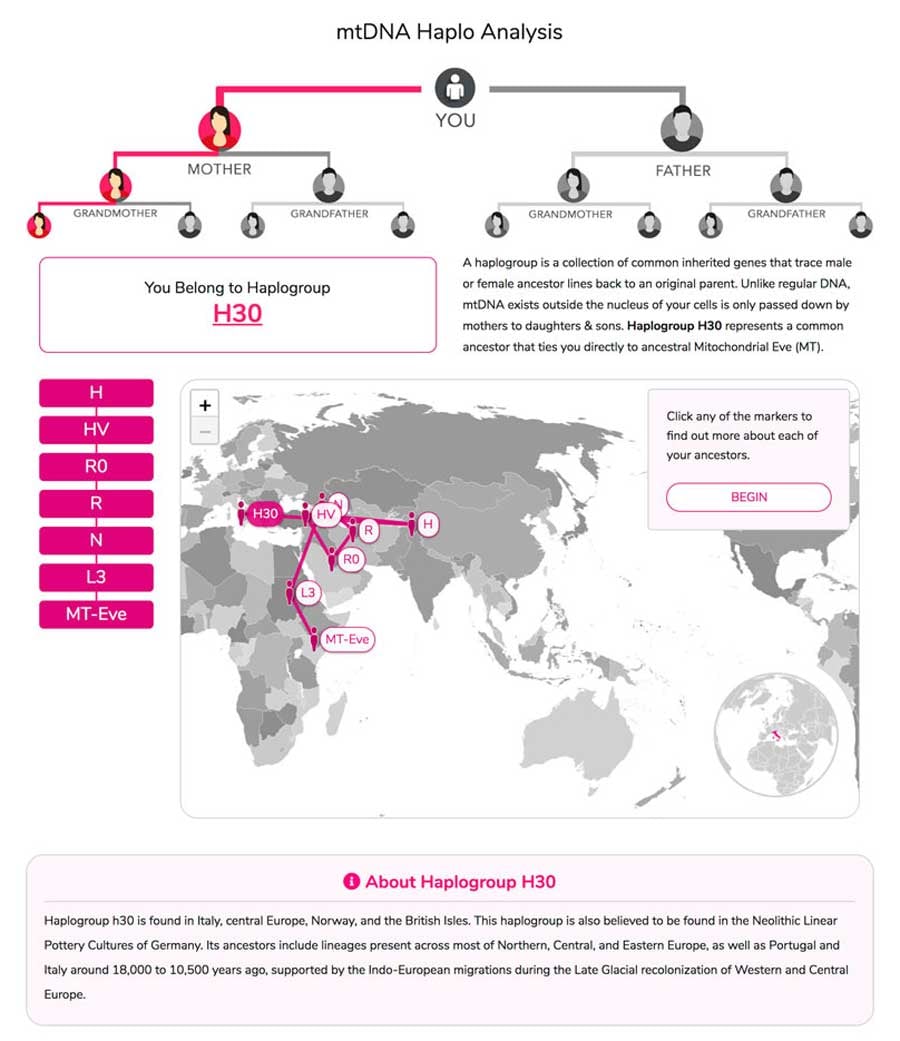
How far have you delved into your ancestry?
If you’re like most people, you’re curious about where you come from. CRI Genetics has set out to connect these missing pieces for people through their ancestry genetic services.
In this article, we’ll explore one of the lingering questions in the minds of many: how many generations does CRI Genetics go back? If you’re new to ancestry testing or learning about your past, prepare to embark on a life-changing journey of self-discovery!
Understanding Genetic Ancestry Testing
To grasp the concept of how far CRI Genetics can trace our ancestry, we must first understand the technology and methodologies employed in genetic ancestry testing. When someone provides a cheek swab sample for ancestry DNA testing, advanced technology is used to determine their ancestry. The main technology used in this process is called genotyping, specifically utilizing Single Nucleotide Polymorphism (SNP) genotyping.
Here's how it works when determining someone’s ancestry using a cheek swab sample:
- Cheek Swab Collection: The individual swabs the inside of their cheek with a specialized swab provided in the DNA testing kit, thus collecting cells from the mucous membrane lining the mouth.
- DNA Extraction: This is the part where the DNA must be extracted from the collected cheek cells. The DNA must be separated from other cellular components and then purified to obtain a concentrated sample.
- SNP Genotyping: This step analyzes specific locations in the person’s genome that are known to have genetic variations (SNPs) associated with different ancestral populations.
- Microarray Technology: A microarray is a small glass slide or chip that contains thousands or millions of DNA probes representing different SNPs. The probes then selectively bind to specific DNA sequences.
- DNA Analysis: This step gets colorful. Fluorescent markers are used to label the extracted DNA, which is then applied to the microarray slide. The DNA binds to the complementary DNA probes on the chip, thus highlighting variations in the person’s genetic material by detecting specific SNPs.
- Scanning and Data Acquisition: Specialized equipment then scans the microarray slide to detect the fluorescent signals emitted by the labeled DNA. The presence or absence of specific genetic variations associated with different ancestral populations is indicated by the signal’s intensity.
- Data Interpretation: Using sophisticated algorithms and software, the raw data obtained from the scanning process is processed and analyzed. The person’s DNA profile is then compared against extensive reference databases from various populations worldwide. That’s how DNA testing companies can estimate someone’s ancestral origins, by comparing their genetic markers to those already in the database.
- Reporting Results: Once the analysis is complete, those who tested receive a detailed report, which provides information about ancestral composition, ethnic origins, migration patterns, or deep ancestral lineages (such as haplogroups).
Note: while genotyping using microarray technology is a commonly used approach, there are many other techniques and technologies available in the world of DNA testing. While different companies may have variations in their methodologies, the principles of genotyping and analyzing genetic markers for determining ancestry remain consistent.
What Does CRI Genetics Tell You?
CRI Genetics utilizes state-of-the-art techniques to delve into the genetic heritage of individuals and can also provide information on genetic markers related to health. When it comes to ancestry, CRI Genetics can do this in three ways.
- Autosomal DNA Testing
Autosomal DNA testing is a powerful tool that offers insights into ancestral origins spanning multiple origins. This type of testing focuses on analyzing the autosomes, the non-sex chromosomes inherited from both parents. By examining autosomal markers, CRI Genetics can uncover deeper ancestral information and provide a comprehensive picture of one’s genetic heritage.
CRI Genetics compares an individual’s autosomal DNA to extensive reference databases that encompass genetic data from diverse populations. By looking at shared genetic patterns and analyzing how certain genetic variations are distributed, CRI Genetics can estimate ancestral origins to give individuals a glimpse into the geographic regions and ethnic groups that are integral to a person’s genetic makeup.
How many generations can CRI Genetics trace your ancestry?
CRI Genetics’ Recent Ancestry reports reveal the last 5-7 generations of your family’s past. The Advanced Ancestry report shows up to 1,000 years of your ancestry for greater detail about your origins, while uncovering hidden surprises. Together, Recent and Advanced Ancestry provide both in-depth AND detailed results, so you get a more complete picture of who you are.
- Paternal Haplogroup Analysis
CRI Genetics examines the Y chromosome, which is passed down exclusively from father to son, to determine the paternal haplogroup. By analyzing specific genetic markers on the Y chromosome, CRI Genetics can trace an individual’s lineage back in time and identify the ancient group of individuals from the which the paternal lineage originated. This haplogroup analysis offers a glimpse into the ancestral migrations and geographic regions associated with the paternal line.
How many generations can CRI Genetics trace your paternal ancestry?
The Paternal Haplogroup report can trace up to 300,000 years of your paternal lineage. Your result depends entirely on your DNA and haplogroup report, as it is specific to each person.
Suggested Reading: Y-DNA and Tracing Your Father's Ancestry: A Woman's Guide to Paternal Lineage
- Maternal Haplogroup Analysis
Similarly, CRI Genetics examines the mitochondrial DNA (mtDNA) inherited exclusively from the mother to determine the maternal haplogroup. The valuable genetic information which mitochondrial DNA contains remains relatively stable over generations. By analyzing specific genetic markers within mtDNA, CRI Genetics can trace an individual’s lineage back in time and identify the ancient group of individuals from the which the maternal lineage originated. This haplogroup analysis offers a glimpse into the ancestral migrations and geographic regions associated with the maternal line.
How many generations can CRI Genetics trace your maternal ancestry?
The Maternal Haplogroup report can trace up to 150,000 years of your maternal lineage. Your result depends entirely on your DNA and haplogroup report, as it is specific to each person.
Suggested Reading: Maternal Ancestry: Not Just For The Ladies

Americans with German ancestry by state according to the U.S. Census Bureau's American Community Survey in 2020
Can CRI Genetics Find Relatives?
At the time of this writing, CRI Genetics does not offer any family finder services, but could add this to their products and services in the future. CRI Genetics can help you trace your ancestry by giving ethnicity estimates, geographic regions where your DNA has likely been, as well as an ancestry timeline tracing back up to 50 generations of your history.
Your Ancestral Heritage, Explained
By examining both paternal and maternal haplogroups, CRI Genetics offers a comprehensive understanding of an individual’s ancestral heritage. Paternal and maternal haplogroups provide unique and specific perspectives, allowing individuals to gain insights into the diverse lineages that contribute to their genetic makeup.
Analyzing these genetic lineages allows CRI Genetics to uncover the ancient origins of individuals, shedding light on the migratory paths and populations that shaped their ancestry over thousands of years.
Suggested Reading: How Many Generations Can a DNA Test Trace My Ancestry?
Discover Where Your Ancestors Came From
Ancestry DNA can tell you what regions your ancestors came from and which traits are specific to only you. By comparing DNA samples from all over the world, you can zero in on your family’s past, learning where they migrated from, when they moved locations, along with other migration patterns.
You are here today because your ancestors, my ancestors, all our ancestors—conquered unbeatable odds (literally, drought, famine, and the Ice Age could have wiped humans out), so they could pass their genes on to subsequent generations… to us.
For more information concerning DNA testing and how to select the best form of testing for your needs, click HERE.
There is a treasure trove of information waiting to be uncovered.
References:
- https://www.thermofisher.com/us/en/home/life-science/pcr/real-time-pcr/real-time-pcr-learning-center/genotyping-analysis-real-time-pcr-information/what-is-genotyping.html
- https://www.crigenetics.com/blog/y-dna-and-tracing-your-fathers-ancestry-a-womans-guide-to-paternal-lineage
- https://www.crigenetics.com/blog/maternal-ancestry-not-just-for-the-ladies
- https://www.crigenetics.com/blog/how-many-generations-can-a-dna-test-trace-my-ancestry